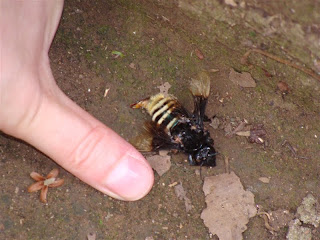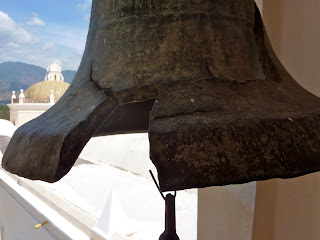-Below: the whole group that stayed up ALL night to make the carpets.

-The insects here are MASSIVE, however it seems that the smaller ones are the ones you really need to look out for! On a recent trip to La Lago we were attacked and almost carried away by swarms of small mosquito's!

-La Cassa de Brett, Nikki et Tina. This is the colourful, cozy apartment that we call 'home.' We have enjoyed having a full kitchen to cook our meals and Nikki and Tina have been cooking with all sorts of interesting vegetables. We usually relax with a good movie and a pot of stove top popcorn during the evenings.

-This power pole is just outside our house (notice the razor edging on our fence/wall). We keep expecting a massive explosion from all these wires, thankfully there hasnt been any problems with the overloaded wiring!

-I know at some point in your life you have asked the question "I wonder where a cashew comes from? " Notice the little grey thing on top of the fruit? thats a cashew! The fruit can be eaten raw or blended into a yummy beverage and the pods are roasted in the oven and then opened to reveal one single cashew nut (we still have to roast our nuts)

-We have friendly geckos that live with us and eat our insects, unfortunately this spider looks big enough to eat the gecko!

-Tina hard at work treating a patient who arrived as we were leaving to go home from the CRIC

-Nikki and our friend Freddy made us peanut milkshakes one day after work. They were so tasty and refreshing! Freddy had some difficulties cutting the milk bag open so Nikki showed him how its done without scissors!


-Can you tell who is in charge at the CRIC? Nikki runs a tight shift and makes sure we do our job right :)

-Nikki helping out!

-Sunscreen and shade is a must on days when we are out in the sun longer than 5 minutes :)
I think we have all managed to get tans even with 60SPF sunscreen!

-This is a common sight around town. Most businesses have security guards with guns, even after being here for 2 months Tina is still not use to seeing them.

-One night, while we were colouring the sawdust for the carpets the "three amigos" (local boys who live down the road) found two horses wandering the streets so they hopped on and rode them around!

-This papaya was one of the best we have ever eaten! The fruit is amazing here! The pineapple is sweet and delicious and the papaya actually has flavour and doesnt taste like cardboard!


































































